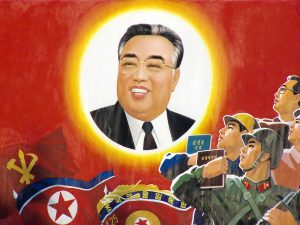In an editorial in The Washington Post earlier this year, Stephen Rademaker, Assistant Secretary of State for International Security and Nonproliferation from 2002–2006, echoed a common line of thought on the North Korean nuclear crisis. He argued that “[i]n the absence of good military options or a Chinese deus ex machina, the remaining options for eliminating the threat are limited. We’ve tried them all, and all have failed.” The implication of his words are clear: We’ve tried diplomacy with North Korea, and it doesn’t work. But a simple look at history proves that diplomacy with North Korea has, in fact, produced successes.
The best example is the Agreed Framework, which was signed in 1994. At the time, intelligence agencies agreed that North Korea had successfully extracted around 12 kilograms of plutonium, enough for one to two nuclear bombs. There was also clear evidence that the regime of Kim Il-sung, the grandfather of Kim Jong-un, was rapidly pursuing other technologies necessary for a nuclear program, including missile technology and conventional munitions needed for detonation. There was also speculation by the CIA that North Korea already had nuclear weapons (they did not).
Serious planning for American strikes on the experimental reactor at Yongbyon, which produced the plutonium, was underway. The situation looked bleak, and by the summer of 1994, President Bill Clinton was sitting through a briefing on military contingency plans on the Peninsula. That’s when former President Jimmy Carter called Washington from North Korea with news that Kim Il-sung had expressed openness to a nuclear freeze in exchange for a light-water reactor (which is considered “proliferation proof”). On October 21 of that year, after four months of intense negotiation, representatives from the United States and North Korea (by then led by Kim Jong-il) met in Geneva to adopt the Agreed Framework.
Under the Agreed Framework, the United States would provide North Korea with a light-water reactor to replace its existing nuclear power facilities by 2003. In the interim, North Korea would freeze the construction of the graphite-moderated reactors at Yongbyon and Taechon with the eventual goal of dismantlement, and stop the use of the experimental plutonium reactor at Yongbyon. All of these sites would be subject to inspections by the International Atomic Energy Agency (IAEA). To address the energy shortage created by the shuttering of these plants until the new light-water reactor was completed, the United States would provide the DPRK with 500,000 tons of heavy oil annually. Existing fuel from the experimental reactor would be disposed of without reprocessing (which is a proliferation risk), and North Korea would remain in the Non-Proliferation Treaty.
For years, the Agreed Framework worked. In 1999, North Korea agreed to talks about ongoing nuclear weapons-related issues outside of the scope of the Agreed Framework. Negotiations over additional agreements were very close to their conclusion when the Clinton administration ran out of time. North Korea remained a fundamentally unpalatable regime, but all available evidence suggested that the Agreed Framework had succeeded at freezing North Korea’s plutonium production capabilities.
Then, things started to fall apart.
The new George W. Bush Administration began a comprehensive review of North Korea policy. While the review dragged on, intelligence findings emerged revealing that North Korea was pursuing a centrifuge program to enrich uranium. This development, while almost certainly part of a nuclear weapons program, fell outside of the scope of the Agreed Framework. Rather than seeking the negotiation of an addendum to the Agreed Framework to address the new centrifuges, voices in the Bush administration long-opposed to the agreement used this new finding as justification to abandon it. John Bolton would later write, “this was the hammer I had been looking for to shatter the Agreed Framework.”
The Agreed Framework was not flawless, and its flaws likely influenced the drafters of the Joint Comprehensive Plan of Action (JCPOA, also known as the Iran deal). Mindful of the need for explicit and exhaustive directives, the full text of the JCPOA is 110 pages long compared to the Agreed Framework’s four pages. Nevertheless, the Agreed Framework constrained a state that was very close to the threshold of nuclear breakout and kept its nuclear ambitions in check for almost a decade. Without it, North Korea would almost certainly have a larger, more dangerous nuclear program.
There are two main lessons of the Agreed Framework. Lesson one is simple: No deal is perfect, but diplomacy can and has worked with North Korea. It is also by far a preferable alternative to military action. Lesson two is that while grand bargains are attractive, they are often infeasible. A surprising amount can be accomplished through strictly implemented, seemingly narrow agreements. Importantly, should initial deals work, follow-on agreements are always possible down the road. While the world will never know for sure, strengthening and saving the Agreed Framework could have prevented the North Korean threats we face today. President Donald Trump and his Administration should keep that in mind as it weighs options for mitigating the current crisis.

